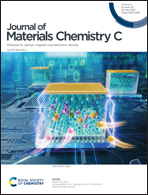Cation doping and strain engineering of CsPbBr3-based perovskite light emitting diodes
Abstract
All-inorganic cesium lead bromide demonstrates better thermal and chemical stability compared to its hybrid counterparts, and thus it can provide a base for high stability and performance of CsPbBr3-based perovskite light emitting diodes (PeLEDs). Appropriate cation doping engineering could further improve the stability and performance of CsPbBr3 films and PeLED devices. Here, the stability and luminescence performances of B-site and A-site cation doped CsPbBr3 films and PeLEDs are summarized and critically compared. The mechanisms of the improved properties after doping are discussed. In addition, a conventional analysis of lattice parameters in terms of spontaneous strains is provided for the first time for CsPbBr3 perovskites, in which they have robust correlations with the stability of the CsPbBr3-based films and PeLEDs. Meanwhile, the cation doping process is an effective method to flexibly modulate the spontaneous strains to enhance the stability and luminescence properties of the metal halide perovskites and PeLEDs. Doping and strain engineering in the field of perovskite optoelectronics will certainly encourage very important future developments in materials science, physics and chemistry for operationally stable PeLEDs.



 Please wait while we load your content...
Please wait while we load your content...